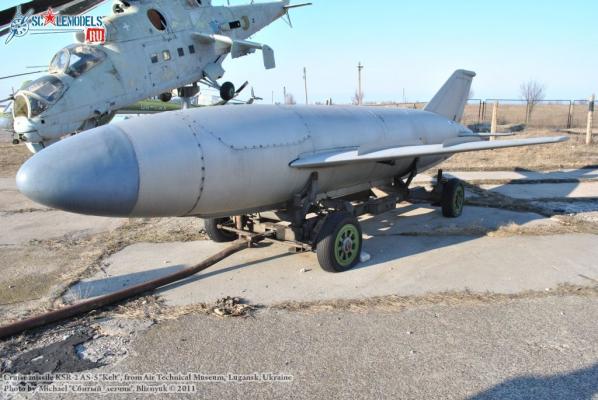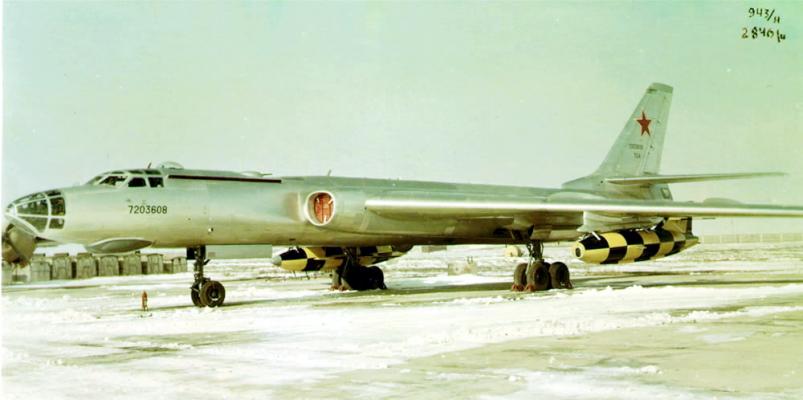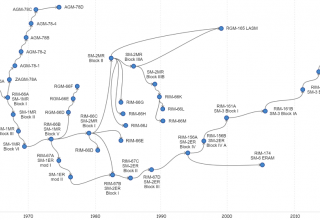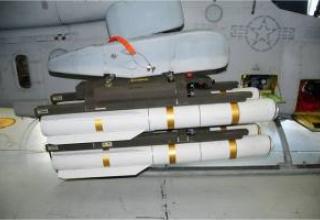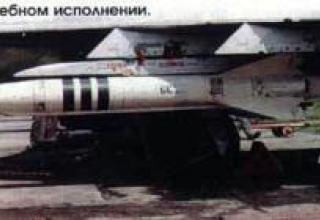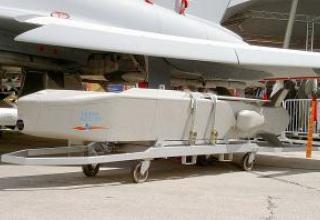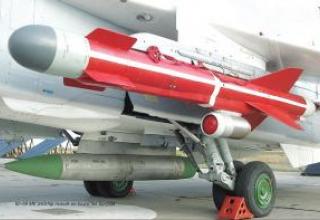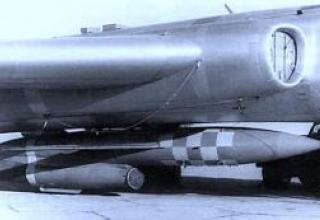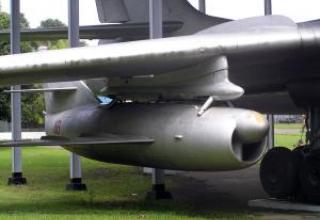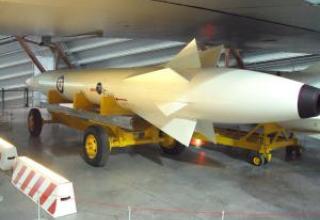KSR-2 (item 085) - an air-based cruise missile of K-16 complex, was developed as a replacement for KS-1 "Kometa" anti-ship missiles. It was designed to engage radar-contrast sea targets such as a cruiser with a displacement of at least 10 thousand tons, as well as land - railroad bridges, dams, etc. The missile was designed to destroy the radar-contrast sea targets.
The missile was developed at OKB-155-1 under the leadership of A.Y. Bereznyak. The liquid propellant rocket engine was developed by KB-300 A. M. Isaev, Rubicon control system - OKB-238. Pilot production of missiles was carried out at Plant No. 256 in Dubna, mass production - at Smolensk Plant No. 292.
Flight testing of missiles as part of the K-16 complex began in 1958, for which the Tupolev Design Bureau-256 re-equipped two Tu-16 aircraft with the Rubicon system. During the tests from the bomber Tu-16KSR was launched 11 rounds at a range up to 100 km. Six projectiles were fired at target ships (Dzhaparidze and Chkalov tankers), while the rest were fired at ground targets marked by corner reflectors. From 6 launches on ships at a range of 90-96 km 4 direct hits were marked, 1 miss and 1 launch was not counted due to failure of the guidance station.
Tests have shown that installed on the aircraft carrier radar guidance station K-PM provides when working on a ground target at an altitude of 4-10 km detection at a range up to 200 km and a steady auto tracking target at a distance of 160-180 km. Target was reset from the auto tracking at a distance of 13-15 km. When working on marine targets the range of detection and taking on auto tracking depended on many factors, including the type of ship and the direction of approach. Thus, at an altitude of the Tu-16KSR five kilometers range of detection of tankers "Dzhaparidze" and "Chkalov" was 140-160 km, and the range of their stable support 120-160 km. It seemed that the tests were going well, but when they went on to launch missiles at a range of 130-150 km, they all failed. The reason - the failure of the aircraft guidance system, it was found and unreliable fuel supply to the LRD missiles at long negative normal overloads. After completing the tests in accordance with the Decree of the USSR CM N 998-435 of August 22, 1959 in the Design Bureau-286 for the missile KSW-2 was developed by an improved homing head with an antenna of increased size - the diameter of the radio transparent fairing has increased almost to a middel rocket. Along with repositioning of the missile nose part, the tail fins were also changed - stabilizer was moved from keel to fuselage.
On December 30, 1961 the missile KSW-2 was adopted by the Decree of the USSR CM N 1261-537, and in February 1962 the Decree on conversion of Tu-16KS and Tu-16 aircraft into carriers of KSW-2 missiles was adopted. The missile system was named K-16, later it was renamed into Tu-16K-16. The complex included a KSR-2 missile and a Tu-16KSR-2 carrier aircraft with Rubicon missile control equipment.
As part of the missile KSKSR-2 began to arrive in February 1963. In total, these missiles were transferred to 4 aviation regiments. The first practical launches were made by crews of the 33rd training center from October 25 to November 23, 1962.
In parallel with the development of the missile in parts were carried out work to reduce the altitude of missile launch. It turned out that it could be launched from an altitude of 2 km. April 22, 1968 was issued an order of the Minister of Defense of the USSR to modify the missile KSR-2 to enable its launch from a height of 0.5 to 10 km. The modified missiles received the SKS-2M index.
According to Resolution No 684 of June 19, 1959, on the basis of the SKS-2 missile, a target missile SKM-2 was created for testing air defense systems.
The world's first antiradar missile, KCW-11 (KCW-2P), was developed on the basis of KCW-2 for the purpose of destroying land and sea radio-radioactive targets. Work on the missile began in accordance with the Decree of the USSR CM of July 20, 1957 and the IAP Order of July 31, 1957. KSK-11 was adopted as part of the K-11 complex (see photo) April 13, 1962. Series production was organized at Plant No. 292 in Smolensk. The high degree of unification of KSW-2 and KSW-11 missiles made it possible to create a single Tu-16K-11-16 complex in the future.
The carriers of KSW-2 missiles were converted and modified Tu-16KS missile carriers (50 machines) and Tu-16A bombers (155 machines). The modified missile carrier received the index Tu-16KSR-2. Later on, 156 more bombers were modified for KSW-2 and a similar design of KSW-11, as well as carriers of missiles KS-1 (Tu-16KS), rescuers Tu-16S (in Tu-16K-11-16). In total, 441 aircraft were modified for K-11 and K-16 complexes, of which 211 served in the Far East and 230 - in the Navy.
Rocket complex Tu-16K-16 had several serious shortcomings. It was subject to radio electronic interference, the range of application was heavily dependent on hydrometeorological conditions, sea disturbance, the speed of the rocket was relatively small. However, the KSW-2 missile was quite steadily pointed at targets, and since each missile could adjust to its frequency, this allowed up to 20 missiles to be used in a salvo without mutual interference. The issue of equipping the Tu-16 with more effective missile weapons was resolved in late 1969 with the adoption of the K-26 complex with missiles KCR-5.
According to NATO classification, the SAC-2 missile was designated AS-5 Kelt.
Composition:
According to the KAC-2 aerodynamic scheme - a monoplane with a mid-wing and plumage (see diagram). The rocket glider consists of an all-metal fuselage, wing and plumage. Wing with a sweep of 55 ° folded during storage and transportation of the missile (see photo). The main material in the construction are aluminum alloys, dural and steel, as well as plastics.
The active radar CNS of KS-2M type had a target acquisition range of up to 160 km (see the layout diagram). The bow radio transparent fairing is made of two layers of fiberglass with honeycomb fiberglass filler. Behind the ARLGSN compartment there is a warhead compartment (BC), in which nuclear or high-explosive batteries of FC-2 type could be installed. The latter had 681 kg of explosives with a total weight of 840 kg and pierced 300 mm ship's armor. For the destruction of ground targets was designed combat unit FC-2H - blast with an active shell.
Behind the BC compartment were located: an oxidizer tank with a capacity of 990 l (1570 kg) and a fuel tank for 630 l (530 kg). TG-02 composition was used as a fuel; AK-20I oxidizer was a solution of nitrogen tetraoxide in concentrated nitric acid. Fuel was supplied to the two-mode LRD C2.721B (later C5.6.000) by turbo-pump unit. The LRD had two modes of operation - starting with a thrust of 1215 kgf and marching with a thrust of 710 kgf. The engine was started at the moment of detaching the projectile at all launch altitudes from 4 to 10 km and carrier speed 400 - 500 km/h.
Between the tanks and the engine is located equipment compartment with pneumatic autopilot AP-72-4, ampoule silver-zinc battery (designed for 500s work), electrical special equipment and air cylinders.
The launch range of the KSW-2 missiles was 160-170 km (see the guidance diagram). The target was a car escort 20-30 km before the missile launch point. In contrast to the Comet, the target was taken by a car escort for an airborne missile radar, not an airplane. In this case, it was possible to direct both missiles to the same target or choose for each of its targets. The missiles were detached one by one. In 7c after detachment the engine was started and acceleration started. The drawdown of the rocket after separation from the aircraft was 600-1200m depending on the height and speed of flight. After 40 c after detaching the time mechanism gave the command to connect the rocket autopilot to the homing radar KS-11M, and the engine was switched to marching mode. By this time the rocket speed reached 1250 km/h. As the missile approached the target at a distance of 15 km station K-11M gave the command to deploy gyroscopes, and the missile control was carried out taking into account the speed of the target. The same command was used to unlock the locking device of the antenna, and after its optical axis was combined with the longitudinal axis of the missile, stopped again. In this mode, the K-11M station operated until the end of the missile's flight. When the target was 450m away, K-11M would issue a command to disable radio control and the missile would continue to fly, maintaining the last position for another 1.2-1.6s, after which it would dive.
KCR-2M
The upgraded KSR-2M missile is designed for low-altitude launches. KCR-2M was equipped with a new dual-mode LCD C5.6.0000.0 (see photo) developed by the Isayev Design Bureau of Chemical Engineering. The autopilot reduced the missile drawdown after the detachment to 150-200 m. After the launch of the LRBM, the rocket smoothly gained an altitude of 500-800 m above the launch vehicle, then moving on to an inclined trajectory controlled by the GSN, with a practical launch range of no more than 70-80 km.
KCR-11 (product 086)
A new autonomous guidance system with a passive self-guided radar head (PARGSN) has been developed for the KCR-11 missile. The passive radar coordinator of the 2RPG-10 target with a target detection range of up to 350 km was used as the SARSAT-11. Structurally, KSW-11 differed from the prototype by the design of fuel intake in tanks, the inner frame of the fuselage. To be placed on the carrier, KSR-11 was equipped with additional suspension units, and the carrier with beam holders DB-352. The missile was launched at a range of 160-170 km. The range of the Tu-16K-11 complex with one missile was 2000 km, the probability of hitting the target was 0.8-0.9.
Missiles guidance (see diagram) was carried out by a combined method - the enemy radar was detected by an airborne target reconnaissance station "Ritza". "Ritsa" detected both observation radars of air defense systems at a distance of 300-350 km, and gun pointing stations at a distance of up to 270 km. The station determined the range, azimuth, radiation frequency, periodicity and duration of pulses. PARGSN missiles were tuned to the frequency of target radiation and took it to the car escort. After detaching the missile flight was in passive mode from the autopilot, from the 40th second included in the work of the PARGSN, performing pointing on the course. In addition to the normal trajectory, there was a possibility of a mode, when the WRD worked until the 60th second in the launch mode and the missile was gaining altitude. With an angular misalignment of the target at 25°, the missile went into a dive to the target with self-guided guidance on course and pitch. When the radar ceased to operate, the CNS target missile kept its flight direction for 25 seconds. A disadvantage of CEB-11 was the limited frequency range of its PAROS, which excluded the use of the missile on a number of ship's radars.
At sea trials, it was planned to use the KCR-11 missile in conjunction with KCR-2.
Characteristics:
| Length, m | 8.59-8.65 |
| Diameter, m | 1,0-1,22 |
| Swing, m | 4,6 |
| Rocket altitude, m | 1,75 |
| Weight, kg | 4,08-4,77 |
| BC | Specialist. 1 Mt, fugas.-kumm FC-2, fugas. with act. obol. FC-2H |
| Weight BC, kg | 684 |
| Guidance System | INSE + ARLGSN X-11M |
| Flight altitude, km | 1,5-10 |
| Range of fire, km | 170-220 (70-150) |
| Height of application, km | up to 9 (1,5-10) |
| Flight Speed, km/h. | 1250 (0,9М - 1,2М) |
| Engine | WRD C2.72 |
| Fuel | ТG-02 |
| Oxidizer | АК-20F |
| PU type | BD-352 |
| Airplane carrier | Tu-16K-11-16, Tu-16K-26, Tu-16K-26P, Tu-16KSR-2-5. |
Testing:
The Tu-16K-16 complex received combat use during the Arab-Israeli War in October 1973. The Tu-16K-11-16 missile carriers of the 36th Squadron of the 403rd Bomb Brigade of General Mohammed Osman El Gendi of the Egyptian Air Force fired a total of 25 KSR-2 and KSR-11 missiles, of which twenty (according to Israeli data) were shot down by fighters and only five hit targets - two radars and a supply warehouse. It should be noted that export DAC-2s could operate on only one frequency. During the fighting, one Tu-16K-11-16 missile carrier was lost.
Sources:
- С.Мороз, С.Попсуевич. Управляемые ракеты дальней и морской авиации СССР
- А.В.Карпенко, С.М.Ганин, В.В.Колногоров. Авиационные ракеты большой дальности. Отечественные авиационные ракеты
- А. Широкорад. История авиационного вооружения
- http://www.missiles.ru
- Крылатая ракета КСР-2, Авиатехнический музей, Луганск
- ОАО "Дубненский машиностроительный завод"
- Якубович Н.В. "Боевые самолеты Туполева", М.: Яуза: Эксмо, 2010.-528с.
